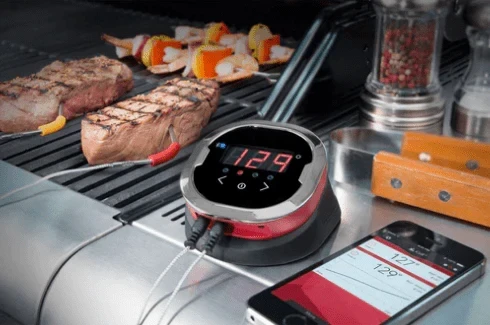Памылка фармату электроннай пошты
emailCannotEmpty
emailDoesExist
pwdLetterLimtTip
inconsistentPwd
pwdLetterLimtTip
inconsistentPwd


Meat Thermometer vs. Instant Read Thermometer: A Comprehensive Guide
When it comes to cooking meat to perfection, having the right tools can make all the difference. Among the essential gadgets in a cook's kitchen are the meat thermometer and the instant read thermometer. While both serve the fundamental purpose of ensuring your meat is cooked to the ideal temperature, they each have unique characteristics that cater to different needs. In this blog post, we'll delve into the differences between these two types of thermometers, exploring their benefits, uses, and how to choose the right one for your kitchen.
Understanding the Basics
Before diving into the specifics, it's important to understand what each type of thermometer does:
Meat Thermometer: This is a broad term that generally refers to devices designed to measure the internal temperature of meat. Meat thermometers come in various forms, including dial (analog) and digital models.
Instant Read Thermometer: This is a specific type of meat thermometer known for its quick response time. Instant read thermometers are typically digital and are designed to provide an accurate temperature reading within seconds.
The Meat Thermometer: A Closer Look
Features and Functions
Traditional meat thermometers, often analog, have been around for a long time. They usually consist of a metal probe with a dial at the end that indicates the temperature. These thermometers work by inserting the probe into the meat, and the temperature is read on the dial.
Analog Meat Thermometers: These have a simple design and are often less expensive. They work well for many home cooks but can be less precise. The dial can be harder to read, and they generally take longer to reach a stable temperature reading compared to instant read models.
Digital Meat Thermometers: These are more modern and can provide faster and more accurate readings. They usually feature a digital display that makes it easier to read the temperature. Some digital models come with additional features like programmable settings for different types of meat and desired doneness levels.
Pros and Cons
Pros:
- Versatility: Can be used for various types of meat, including poultry, beef, pork, and lamb.
- Accuracy: Digital models offer precise readings and often have additional features like timers and alarms.
- Ease of Use: Digital models typically have an easy-to-read display, making them user-friendly.
Cons:
- Speed: Analog models can be slow to provide a stable reading.
- Durability: Digital models can be susceptible to damage from high heat or moisture.
- Cost: Digital models are usually more expensive than their analog counterparts.

The Instant Read Thermometer: A Closer Look
Features and Functions
Instant read thermometers are designed for quick, on-the-spot temperature checks. They are usually digital and feature a thin probe that provides near-instantaneous readings.
Speed: Instant read thermometers are known for their rapid response time. They can deliver a temperature reading in just a few seconds, making them ideal for checking the doneness of meat without having to wait.
Precision: These thermometers are highly accurate, often providing readings within 1-2 degrees Fahrenheit of the actual temperature. This precision is crucial for achieving the perfect level of doneness.
Pros and Cons
Pros:
- Speed: Provides temperature readings almost immediately, which is especially useful when cooking larger cuts of meat.
- Accuracy: Highly precise, ensuring that you can achieve the exact level of doneness you desire.
- Convenience: Easy to use and often portable, making it handy for grilling or camping.
Cons:
- Limited Use: Instant read thermometers are not ideal for monitoring the temperature over a long period. They are best used for quick checks rather than continuous monitoring.
- Battery Dependency: Most instant read models are battery-operated, so you'll need to keep an eye on battery life.
Comparing the Two: Which One is Right for You?
Cooking Style and Needs
Your choice between a meat thermometer and an instant read thermometer largely depends on your cooking style and specific needs:
If you frequently roast or cook large cuts of meat: A meat thermometer with an oven-safe probe, often digital, can be more practical. It allows you to monitor the temperature over a longer period without having to open the oven.
If you prefer quick checks and grilling: An instant read thermometer is likely the better choice. Its speed and accuracy make it ideal for checking the doneness of meat quickly, especially on the grill or stovetop.
Budget Considerations
For Budget-Conscious Cooks: Analog meat thermometers are usually the most affordable option. They can be a good starting point if you're new to using thermometers.
For Those Willing to Invest: Digital meat thermometers and instant read models can be more expensive but offer additional features and faster, more accurate readings. They are a worthwhile investment for serious cooks.
Tips for Using Meat Thermometers
Regardless of the type of thermometer you choose, proper usage is key to achieving the best results:
Calibrate Your Thermometer: Regularly calibrate your thermometer to ensure accurate readings. Most digital models come with instructions on how to do this.
Insert the Probe Correctly: For meat thermometers, insert the probe into the thickest part of the meat, avoiding bone and fat. For instant read thermometers, insert the probe into the center of the meat.
Check for Doneness: Different types of meat have different temperature requirements. Familiarize yourself with the recommended temperatures for various meats to ensure proper doneness.
Clean After Use: Always clean your thermometer probe after each use to prevent cross-contamination.
Conclusion
In the battle of meat thermometer vs. instant read thermometer, there isn't a clear winner—each has its strengths and ideal applications. A traditional meat thermometer, especially a digital one, offers continuous monitoring and versatility, while an instant read thermometer excels in speed and precision for quick checks. Understanding your cooking habits and needs will guide you in choosing the right tool to help you cook meat to perfection every time.
Whichever thermometer you choose, remember that the goal is to ensure your meat is cooked safely and deliciously. By investing in the right equipment and using it correctly, you'll elevate your cooking game and enjoy perfectly cooked meals every time.

